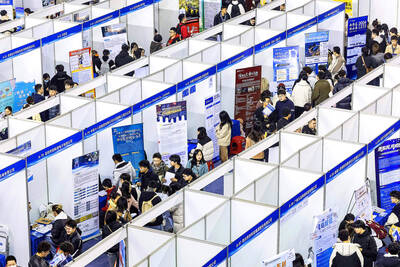The collapse of Parmalat is turning into one of the most bizarre as well as one of the biggest fraudulent bankruptcies in Europe for decades.
The repercussions are putting bankers, auditors and regulators under the spotlight in many parts of the world as investigators unravel clues to how many billions of euros may be missing, for how long and why.

PHOTO: AP
Parmalat, they seem to have discovered, was held together by a Milky Way of companies and accounts to service food activities from South and North America to Europe and Australia -- and allegedly to dress up scanty finances and siphon funds into other pockets.
Among countries touched by the investigation are: Austria, Brazil, Cayman Islands, Germany, Luxembourg, Italy, the Netherlands, Switzerland, the US, and Venezuela.
The affair has also besmirched some top names in finance which had dealings with the group. Among banks in the spotlight are Citigroup, Bank of America, JP Morgan, Deutsche Bank, ABN Amro, UBS, Banco Santander Central Hispano, and in Italy, Banca Intesa and Capitalia.
It has also embarrassed international auditing groups Grant Thornton and Deloitte and Touche which Parmalat, under administration by rescue specialist Enrico Bondi, dismissed recently.
But it is in Europe that the continuous stream of revelations is hitting hardest.
The EU Commission, as well as the Italian government, is reviewing ways to strengthen watchdogs.
The commission has said it must "begin to analyse the implications for EU financial services policies" and that in February it would tighten proposals on auditing to "greatly strengthen the oversight of audit firms."
The Italian government has criticized the Consob stock regulator and Bank of Italy for their monitoring of Parmalat and is working on new financial regulations "with urgency to give a response to the international markets which want to be told that Italy is a safe country".
And the Organization for Economic Cooperation and Development has redrafted guidelines, originally intended for emerging countries, in response to frauds of the Enron and WorldCom type but made specific reference to Parmalat when it published them this week.
OECD director general Donald Johnston declared: "It's clear there are a number of areas where changes are needed, and this is most striking in the Parmalat affair ... We never contemplated a need to discuss this in the United States and Europe."
The astonishing story of how the rapid rise of the Italian food empire built on milk came to end in tears for many, has been unfolding for six weeks. Several enquiries are under way and nine people have been detained for suspected fraud.
In all, 26 people have been told they are being investigated with a view to charges being laid, a procedure which gives them access to evidence.
No formal charges have been laid and much of the picture has emerged through press reports and allegations by investigators. But the company is insolvent and 36,000 employees are waiting to hear if the Italian state will orchestrate a rescue or if predators will pick up the pieces.
The plot so far, unproved but widely told, is worthy of the most imaginative scriptwriter: Calisto Tanzi, a young man in Parma, the home of Italian cured ham and Parmesan cheese, takes over his family's small meat business in the 1960s, diversifies into milk and builds a global empire.
Parmalat buys a second-rate football club -- Parma -- and turns it into a European winner. Tanzi puts his son in charge. "Don Calisto" is said to fund the renovation of churches and to ferry politicians and prelates in company aircraft.
But behind this facade, in the last decade Tanzi and a few key managers allegedly invent accounts and assets.
And they create documents to clothe the fiction in order to cover poor performance and to divert funds, into a failing local travel company, Parmatour, controlled by his daughter, for example.
And with this world of make-believe they fool banks and auditors, -- until bond payments fall due and financial entities with such names as Bonlat, Epicurum or Buconero -- black hole in English -- are revealed as the top of a bottomless pit.
The company's telephone manager turns out to have been the titular head of about 30 companies. Investigators say that each time they open a set of books they find more nasty surprises.
Many shocking but colorful European corporate frauds of the last 25 years come to mind: the Maxwell pension fund fraud and the collapse of Barings bank in Britain, for example.
One of the strangest was the collapse of the Italian Banco Ambrosiano in the early 1980s with links to an alleged right-wing political plot and separately to the Vatican.
The mafia is suspected of having murdered one key figure, and a close associate banker died in prison after drinking poisoned coffee.
However, the Parmalat affair, "one of the largest and most brazen financial frauds in history" in the words of US regulators, stands out because it is bizarre, reaches into many countries and seems certain to change regulatory thinking.

Stephen Garrett, a 27-year-old graduate student, always thought he would study in China, but first the country’s restrictive COVID-19 policies made it nearly impossible and now he has other concerns. The cost is one deterrent, but Garrett is more worried about restrictions on academic freedom and the personal risk of being stranded in China. He is not alone. Only about 700 American students are studying at Chinese universities, down from a peak of nearly 25,000 a decade ago, while there are nearly 300,000 Chinese students at US schools. Some young Americans are discouraged from investing their time in China by what they see

Taiwan Transport and Storage Corp (TTS, 台灣通運倉儲) yesterday unveiled its first electric tractor unit — manufactured by Volvo Trucks — in a ceremony in Taipei, and said the unit would soon be used to transport cement produced by Taiwan Cement Corp (TCC, 台灣水泥). Both TTS and TCC belong to TCC International Holdings Ltd (台泥國際集團). With the electric tractor unit, the Taipei-based cement firm would become the first in Taiwan to use electric vehicles to transport construction materials. TTS chairman Koo Kung-yi (辜公怡), Volvo Trucks vice president of sales and marketing Johan Selven, TCC president Roman Cheng (程耀輝) and Taikoo Motors Group

MAJOR DROP: CEO Tim Cook, who is visiting Hanoi, pledged the firm was committed to Vietnam after its smartphone shipments declined 9.6% annually in the first quarter Apple Inc yesterday said it would increase spending on suppliers in Vietnam, a key production hub, as CEO Tim Cook arrived in the country for a two-day visit. The iPhone maker announced the news in a statement on its Web site, but gave no details of how much it would spend or where the money would go. Cook is expected to meet programmers, content creators and students during his visit, online newspaper VnExpress reported. The visit comes as US President Joe Biden’s administration seeks to ramp up Vietnam’s role in the global tech supply chain to reduce the US’ dependence on China. Images on

New apartments in Taiwan’s major cities are getting smaller, while old apartments are increasingly occupied by older people, many of whom live alone, government data showed. The phenomenon has to do with sharpening unaffordable property prices and an aging population, property brokers said. Apartments with one bedroom that are two years old or older have gained a noticeable presence in the nation’s six special municipalities as well as Hsinchu county and city in the past five years, Evertrust Rehouse Co (永慶房產集團) found, citing data from the government’s real-price transaction platform. In Taipei, apartments with one bedroom accounted for 19 percent of deals last